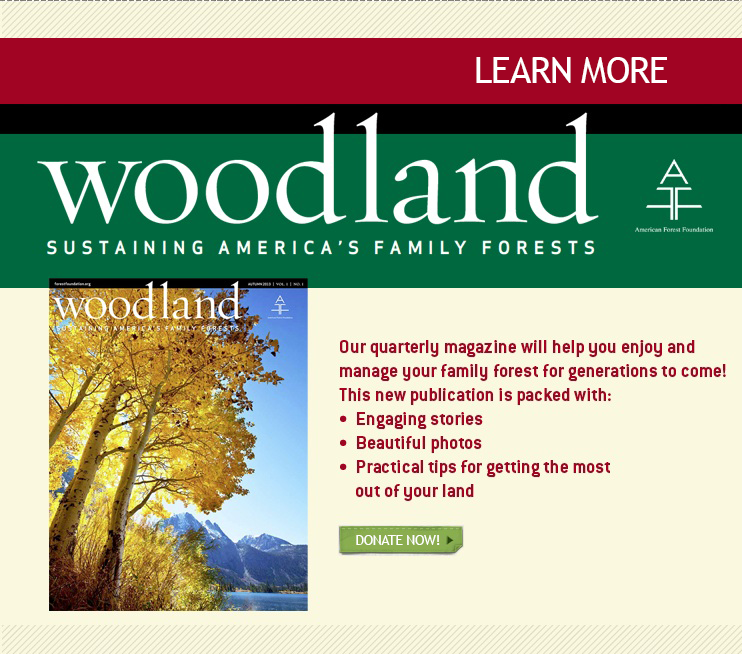Tree Farmer Profile: Bob French, New Hampshire

- By Kathy Westra
For 87-year-old Tree Farmer Robert (Bob) L.V. French, family forests are a legacy—a legacy from his grandfather and for his grandchildren. The 2014 New Hampshire Tree Farmer of the Year was inspired to go into forestry by his grandfather, a timber dealer who supplied Tennessee hardwood to Henry Ford for use in the Model T.
A century later, French, his wife Shirley, their three children and their 10 grandchildren are continuing that legacy, sustainably managing their woodlands for new generations. This legacy will benefit not only their family, but many others through donated conservation easements that will forever protect the economic and ecological benefits that the Frenchs’ sustainable working forests provide.
Bob French is a native New Englander who has spent decades acquiring the 40 parcels of forestland that now make up Greentree Forest–Meadowsend Sawmill, his 2,407-acre Tree Farm in New London, N.H. The property has been certified by the American Tree Farm System® since 1982. Today, Bob’s sons, Steven, managing partner of Meadowsend Timberlands LLP and president of Abenaki Timber Corp., and Jameson (“Jamey”), president of Northland Forest Products, carry out Bob’s long-term vision for the land.
New Hampshire Tree Farm Chair Brian Johnson praises Bob French for assembling a patchwork of forest parcels “into a cohesive, sustainably managed, working forest.” This work, Johnson said in a letter telling Bob French of his Tree Farmer of the Year award, demonstrates “dedication, vision and patience. Your Greentree Forest represents a quintessential example of the spirit of the Tree Farm program [and] will forever remain a natural tribute to your family’s conservation heritage, a testament to your own personal efforts and vision, and an ongoing legacy to your family and to the state of New Hampshire.”
Forester Jeremy Turner has been working at Greentree Forest since Bob hired him as a college student in 1996. “Bob has a tremendous background and history of land management and forestry and the lumber business,” Turner says. “As he picked up knowledge throughout his life, he was able to develop an approach that meshed with his vision—and he’s a really visionary guy. He can see things that most of us can’t, imagine things that are possible and then translate ideas and concepts into practice. You need a vision of long-term, sustainable stewardship, and that’s what Bob has.”
“Creative conservation is something my father has been known for,” says Jamey French. “He has always taken the long-term approach, talking about growing trees for his grandchildren.”
As he acquired parcels, Bob French had the ability to see the potential in a piece of forestland. “If he saw good value in the types of trees that were growing there, he wasn’t afraid to take on a forest that could produce well with proper management,” Jamey French adds.
French uses multiple-age management techniques to grow and harvest white pine and red oak for saw logs, pulpwood and biomass chips. Meadowsend Sawmill is also a working beef cattle farm with 140 acres of fields, seven ponds and 120 acres of wetlands with 30 acres of open water for wildlife habitat.
Both father and sons are big believers in using conservation easements to protect land for future generations (see story on page 1). “In the Northeast, easements have been used by Tree Farm families for longer than elsewhere in the country,” says Jamey French, who serves as vice chair of the Land Trust Alliance. His father was in the vanguard of the movement; in 1975, Bob French donated an easement on a working forest lot at a time when this was a novel approach. Since then, he and Shirley have donated easements on 20,000 acres in five states. They donated an easement on Greentree Forest to a local land trust, the Society for the Protection of New Hampshire Forests, in 2001.
“It was just the right thing to do because I inherited a love for the land from my grandparents,” Bob French told the Land Trust Alliance’s magazine, Saving Places. “We have forgotten how to give in this country, and we need to learn how to give again, and how to give back to the land. More people should be given the idea to use family property for the greater good.”










Comments: